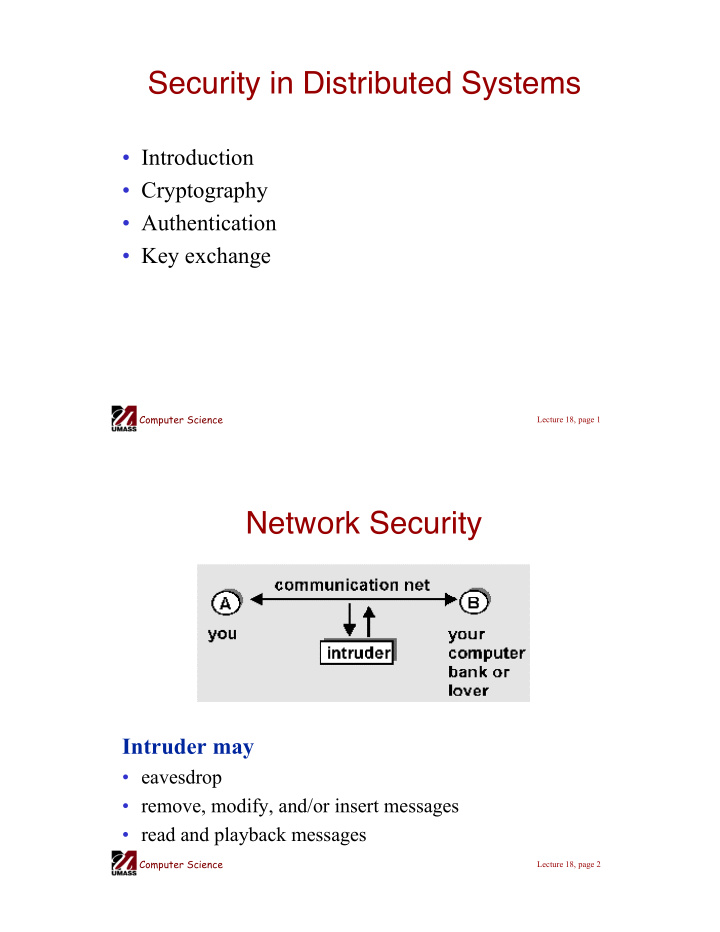



Security in Distributed Systems • Introduction • Cryptography • Authentication • Key exchange Computer Science Lecture 18, page 1 Network Security Intruder may • eavesdrop • remove, modify, and/or insert messages • read and playback messages Computer Science Lecture 18, page 2
Issues Important issues: • cryptography: secrecy of info being transmitted • authentication: proving who you are and having correspondent prove his/her/its identity Computer Science Lecture 18, page 3 Security in Computer Networks User resources: • login passwords often transmitted unencrypted in TCP packets between applications (e.g., telnet, ftp) • passwords provide little protection Computer Science Lecture 18, page 4
Security Issues Network resources: • often completely unprotected from intruder eavesdropping, injection of false messages • mail spoofs, router updates, ICMP messages, network management messages Bottom line: • intruder attaching his/her machine (access to OS code, root privileges) onto network can override many system- provided security measures • users must take a more active role Computer Science Lecture 18, page 5 Encryption plaintext: unencrypted message ciphertext: encrypted form of message Intruder may • intercept ciphertext transmission • intercept plaintext/ciphertext pairs • obtain encryption decryption algorithms Computer Science Lecture 18, page 6
A simple encryption algorithm Substitution cipher: abcdefghijklmnopqrstuvwxyz poiuytrewqasdfghjklmnbvczx • replace each plaintext character in message with matching ciphertext character: plaintext: Charlotte, my dear ciphertext: iepksgmmy, dz uypk Computer Science Lecture 18, page 7 Encryption Algo (contd) • key is pairing between plaintext characters and ciphertext characters • symmetric key: sender and receiver use same key • 26! (approx 10^26) different possible keys: unlikely to be broken by random trials • substitution cipher subject to decryption using observed frequency of letters – 'e' most common letter, 'the' most common word Computer Science Lecture 18, page 8
DES: Data Encryption Standard • encrypts data in 64-bit chunks • encryption/decryption algorithm is a published standard – everyone knows how to do it • substitution cipher over 64-bit chunks: 56-bit key determines which of 56! substitution ciphers used – substitution: 19 stages of transformations, 16 involving functions of key Computer Science Lecture 18, page 9 Symmetric Cryptosystems: DES (1) a) The principle of DES b) Outline of one encryption round Computer Science Lecture 18, page 10
Symmetric Cryptosystems: DES (2) • Details of per-round key generation in DES. Computer Science Lecture 18, page 11 Key Distribution Problem Problem: how do communicant agree on symmetric key? – N communicants implies N keys Trusted agent distribution: – keys distributed by centralized trusted agent – any communicant need only know key to communicate with trusted agent – for communication between i and j, trusted agent will provide a key Computer Science Lecture 18, page 12
Key Distribution We will cover in more detail shortly Computer Science Lecture 18, page 13 Public Key Cryptography • separate encryption/decryption keys – receiver makes known (!) its encryption key – receiver keeps its decryption key secret • to send to receiver B, encrypt message M using B's publicly available key, EB – send EB(M) • to decrypt, B applies its private decrypt key DB to receiver message: – computing DB( EB(M) ) gives M Computer Science Lecture 18, page 14
Public Key Cryptography • knowing encryption key does not help with decryption; decryption is a non-trivial inverse of encryption • only receiver can decrypt message Question: good encryption/decryption algorithms Computer Science Lecture 18, page 15 RSA: public key encryption/decryption RSA: a public key algorithm for encrypting/decrypting Entity wanting to receive encrypted messages: • choose two prime numbers, p, q greater than 10^100 • compute n=pq and z = (p-1)(q-1) • choose number d which has no common factors with z • compute e such that ed = 1 mod z , i.e., integer-remainder( (ed) / ((p-1)(q-1)) ) = 1 , i.e., ed = k(p-1)(q-1) +1 • three numbers: – e, n made public – d kept secret Computer Science Lecture 18, page 16
RSA (continued) to encrypt: • divide message into blocks, { b_i} of size j : 2^j < n • encrypt: encrypt(b_i) = b_I^e mod n to decrypt: • b_i = encrypt(b_i)^d to break RSA: • need to know p, q , given pq=n , n known • factoring 200 digit n into primes takes 4 billion years using known methods Computer Science Lecture 18, page 17 RSA example • choose p=3 , q=11 , gives n=33 , (p-1)(q- 1)=z=20 • choose d = 7 since 7 and 20 have no common factors • compute e = 3 , so that ed = k(p-1)(q-1)+1 (note: k=1 here) Computer Science Lecture 18, page 18
Further notes on RSA why does RSA work? • crucial number theory result: if p, q prime then b_i^((p-1)(q-1)) mod pq = 1 • using mod pq arithmetic: (b^e)^d = b^{ed} = b^{k(p-1)(q-1)+1} for some k = b b^(p-1)(q-1) b^(p-1)(q-1) ... b^(p-1)(q-1) = b 1 1 ... 1 = b Note: we can also encrypt with d and encrypt with e . • this will be useful shortly Computer Science Lecture 18, page 19 How to break RSA? Brute force: get B's public key • for each possible b_i in plaintext, compute b_i^e • for each observed b_i^e , we then know b_i • moral: choose size of b_i "big enough" Computer Science Lecture 18, page 20
Breaking RSA man-in-the-middle: intercept keys, spoof identity: Computer Science Lecture 18, page 21
Recommend
More recommend